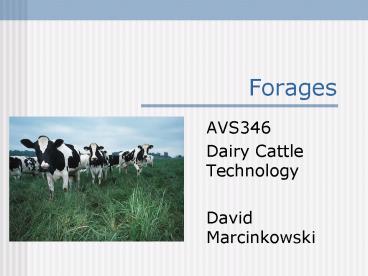Forages - PowerPoint PPT Presentation
1 / 48
Title:
Forages
Description:
Both cool and warm season. Legumes. Small grains. Row crops. Alternative forages crops ... Quality varies through the season. Lack of control in feeding program ... – PowerPoint PPT presentation
Number of Views:813
Avg rating:3.0/5.0
Title: Forages
1
Forages
- AVS346
- Dairy Cattle Technology
- David Marcinkowski
2
Forages
- Required for healthy cow
- Only good source of effective fiber
- Cheapest source of nutrients
- Homegrown
- Most closely meets most cattle's needs
3
Nutrients Supplied by Forages
Cow 1400BW, 40Milk/Day Forage - Immature
Grass Hay
4
Forage Plant Species
- Grasses
- Both cool and warm season
- Legumes
- Small grains
- Row crops
- Alternative forages crops
5
Grasses
- 2 Types
- Cool and Warm (Not in ME)
- Most common forages in Maine
- Grows best in the spring and fall when
temperatures are cooler and conditions wetter - Summer slump
- Tolerates heavy, wet, acids soils
- Vigorous and winter hardy
- Fills in thinning stands
- Nutritional value compared with legumes
- Lower in protein
- Higher in fiber
- Needs to be cut earlier to maintain quality
6
Timothy
7
Orchardgrass
8
Bromegrass
9
Reeds Canarygrass
10
Tall Fescue
11
Kentucky Bluegrass
12
Small Grains
- Barley
- Oats
- Wheat
- Rye
- Triticale Wheat X Rye
13
Small Grain Forage
- Used for hay, silage or grain/straw
- Advantages
- High yielding
- Heavy feeders of nutrients
- One harvest
- Plant in fall or spring
- High energy
- Disadvantages
- Fiber content of stalk
- Palatability
- Harvest at right stage
- Boot stage for quality
- Dough stage for energy
14
Barley
15
Oats
16
Wheat
17
Rye
18
Triticale
19
From Understanding Silage Management Penn State
20
Stage of maturity affects yields and nutrient
content of wheat forage
(Oltjen and Bolsen, KSU, 1978).
21
Analysis of Small Grain Silages
NRC Requirements of Dairy Cattle 2001
22
Row Crop Silages
- Corn and Sorghum-Sudangrass
- Advantages
- High yield/acre
- Can use large quantities of manure
- Disadvantages
- Annual
- Low protein
- Erosion potential
- Must be harvested as silage
- Requires warm temperatures
23
Sorghum Sudangrass
24
Corn
25
Corn Silage
- Advantages
- Highest in energy
- Highest DM yields per acre
- Ferments easily in silo
- consistancy
- Palatability
- Utilize manure nutrients
- One cutting
- Disadvantages
- Requires good dry land
- Hot growing season
- Very low in protein
- Soil erosion
- Low quality protein
26
Legumes
- Alfalfa, Clovers, Birdsfoot Trefoil
- Advantages
- Higher in protein
- Lower in fiber
- Deep roots, drought tolerant
- Multiple cuttings
- Disadvantages
- Takes longer to dry
- Winter kill
- Does poorly in wet soils
27
Alfalfa
28
Clover
Red
White
29
Birdsfoot Trefoil
30
Hay Quality Requirements of Different Animals
31
Grass Hay Variation
Northeast DHIA Data
32
Maturation of Plant Cell Wall
33
Alfalfa DM Yield with Stages of Maturity
34
Orchardgrass Digestibility
Adapted from Fulkerson (1983)
35
Factors Affecting Forage Quality
- Soil type and fertility
- Variety of plant
- Plant species mix
- Weeds and weed type
- Age of stand
- Winterkill
- Weather, including
- temperature
- humidity
- season (day length)
- season (type -- cold, late)
- moisture (rain)
- length of time between cutting and rain
- Plant maturity
- Insect damage
- Disease
- Mower height
- Haying equipment -- bale package, bale
ventilation - Time between cutting and harvest
- Plant moisture at harvest
- Time of day hay is cut
- Drying agents Preservatives
- Artificial drying
- Storage methods
36
Mixed Hay Quality by Stage of Maturity
37
Growing Season Affects on Alfalfa
38
Milk Line
39
Milk Stage
40
Dough Stage
41
Dent Stage
42
Corn Silage Maturity
43
Optimum DM Content for Good Silage-making
44
Harvest Losses
45
Hay
- Advantages
- Protein content can be high
- Some hay is desirable in the ration to maintain
rumen function - Low equipment and facilities cost
- Disadvantages
- High labor requirement
- Waste may be a problem
- Greater risk from weather at harvest
- Tonnage is usually lower than row-crop silage
46
Haylage
- Advantages
- Protein content can be high
- Adapted to automation
- Less weather risk at harvest
- Reduced waste
- Disadvantages
- Nutrient loss from spoilage can be significant
- High investment in equipment and facilities
- Limited market for surplus forage
- Tonnage is usually lower than row-crop silage
47
Row Crop Silage
- Advantages
- High tonnage
- Adapted to automation
- Reduced waste
- Disadvantages
- High investment
- Low protein content
- Nutrient loss from spoilage can be high
- Limited market for surplus
- Erosion potential
48
Pasture
- Advantages
- Low harvesting cost
- Reduces time spent on concrete
- Manure is spread
- High quality feed possible
- Disadvantages
- Not well adapted to large herds or confinement
systems - Quality varies through the season
- Lack of control in feeding program
- Increased maintenance requirement































